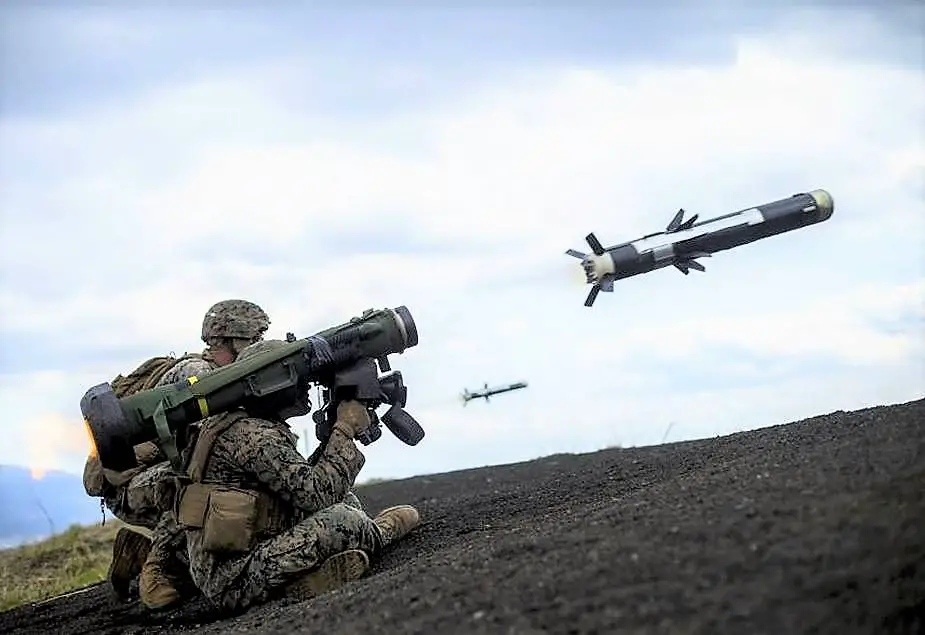Breaking news
US to sell more FGM-148 Javelin antitank missiles to Georgia.
According to Civil Georgia website, the Government of Georgia said it is working to purchase an additional supply of FGM-148 Javelin man-portable anti-tank missiles from the United States, following the August 2021 decision of the U.S. Department of State to approve a possible Foreign Military Sale to Tbilisi.
Follow Army Recognition on Google News at this link

USMC Lance Cpl. Justin Cooper and Cpl. Jacob Siemsen fire a Javelin missile at Combined Arms Training Center Camp Fuji, Japan, April 12, 2021 (Picture source: U.S. DoD)
The Ministry of Defense of Georgia will address simplified procurement worth USD 26,246,866 million, covered with the amount allocated by the U.S. and, in line with the U.S.-Georgia agreement, with sums transferred from the Georgian state budget. Civil Georgia recalls that the U.S. Embassy in Tbilisi reported in August 2021 that the Georgian Government had requested to buy 82 FGM-148 Javelin Missiles and 46 Javelin Command Launch Units (CLU), as well as Enhanced Producibility Basic Skills Trainers; Missile Simulation Rounds, Security Assistance Management Directorate Technical Assistance, Tactical Aviation and Ground Munitions Project Office Technical Assistance, other associated equipment and services, and other related elements of logistical and program support.
The U.S. first approved Georgia to purchase 410 Javelin missiles and 72 Javelin command launch units in November 2017 for an estimated cost of USD 75 million. The sophisticated weaponry arrived in Georgia in January 2018.
The FGM-148 Javelin is a man-portable, fire-and-forget anti-tank missile fielded to replace the M47 Dragon anti-tank missile in US service. It uses automatic infrared guidance that allows the user to seek cover immediately after launch, as opposed to wire-guided systems, like the Dragon, which requires the user to guide the weapon throughout the engagement. The Javelin's HEAT warhead is capable of defeating modern tanks by hitting them from above where their armor is thinnest (see top-attack), and is also useful against fortifications in a direct attack flight.
The system takes a top-attack flight profile against armored vehicles (attacking the top armor, which is generally thinner), but can also take a direct-attack mode for use against buildings, targets inside the minimum top-attack engagement range, and targets under obstructions. The missile also has the ability to engage helicopters in direct attack mode. It can reach a peak altitude of 150 m (490 ft) in top-attack mode and 60 m (200 ft) in direct-fire mode. It is equipped with an imaging infrared seeker. The tandem warhead is fitted with two shaped charges: a precursor warhead to detonate any explosive reactive armor and a primary warhead to penetrate base armor.
The missile is ejected from the launcher so that it reaches a safe distance from the operator before the main rocket motors ignite – a "soft launch arrangement". This makes it harder to identify the launcher; back-blast from the launch tube still poses a hazard to nearby personnel. Via the "fire-and-forget" system, the firing team may change their position as soon as the missile has been launched or prepare to fire on their next target while the first missile is in the air.
The missile system is most often carried by a two-person team consisting of a gunner and an ammunition bearer, although it can be fired with just one person if necessary. While the gunner aims and fires the missile, the ammo bearer scans for prospective targets, watches for threats, such as enemy vehicles and troops and ensures that personnel and obstacles are clear of the missile's backblast.




























